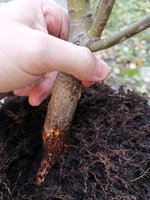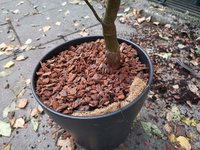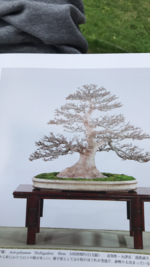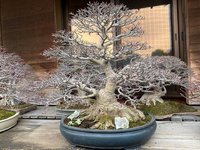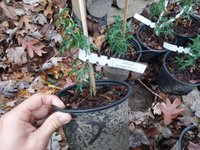Hoyonokuma
Mame
Hi everyone.
Was walking through the local garden center a few days ago with the intention to buy some insulating material to protect my plants' roots during fall.
I stumbled in this lonely Shishigashira that was on sale for less than 20€ so I said, why not
The amount of possibilities due to low branching and the diameter of the trunk (1 meter tall, 3cm of d) turned it for my unexperienced eyes into a reasonable deal (I've spent much more on weaker and lesser developed maples on Maillot).
Now, my newbie eye tells me I have 2 'possible fronts' (A, B) :
A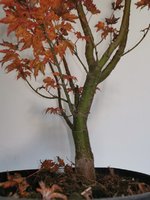
B
Other views

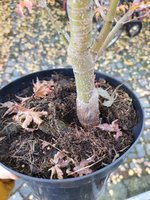
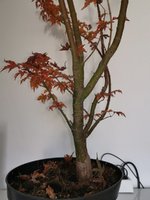

Of course, I'll need to repot it next March/April 'cause I can't even see the nabari, due to the number of superficial roots and how deep it was planted, and second because I'd like to grow it in a better draining soil.
My questions to you are various..
1. What front? I'd probably go with B as of now.
Then, about those 2 low branches: one will have to go I suppose, as they're competing for the same spot and leaving them both would possibly create visible inverse taper.
Between those, I'd opt to get rid of the bottom one and probably guy wire the other into a slightly steeper angle.
The latter also has some better movement and start of ramification.
(correct me if it ain't make no sense)
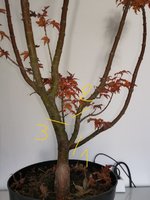
Next is: should I clip the main trunk (or even air layer it) and make a new leader of the only left (slightly wired) branch?
I recon Mach had some troubles with having Shishigashiras backbudding.
Shall I still go for the Clip and Grow or can I let the main trunk grow taller and still end up with a decent taper, sometime before retirement? (I'm 28)lol
Other option I see is: shouldn't I keep the early ramification instead, and cut it all back to increase branching/future movement? Or would that leave me with 0 lower taper?

Thanks in advance for any consideration on the matter.
I wish ya'll a good Sunday.
Federico
Was walking through the local garden center a few days ago with the intention to buy some insulating material to protect my plants' roots during fall.
I stumbled in this lonely Shishigashira that was on sale for less than 20€ so I said, why not
The amount of possibilities due to low branching and the diameter of the trunk (1 meter tall, 3cm of d) turned it for my unexperienced eyes into a reasonable deal (I've spent much more on weaker and lesser developed maples on Maillot).
Now, my newbie eye tells me I have 2 'possible fronts' (A, B) :
A

B

Other views




Of course, I'll need to repot it next March/April 'cause I can't even see the nabari, due to the number of superficial roots and how deep it was planted, and second because I'd like to grow it in a better draining soil.
My questions to you are various..
1. What front? I'd probably go with B as of now.
Then, about those 2 low branches: one will have to go I suppose, as they're competing for the same spot and leaving them both would possibly create visible inverse taper.
Between those, I'd opt to get rid of the bottom one and probably guy wire the other into a slightly steeper angle.
The latter also has some better movement and start of ramification.
(correct me if it ain't make no sense)

Next is: should I clip the main trunk (or even air layer it) and make a new leader of the only left (slightly wired) branch?
I recon Mach had some troubles with having Shishigashiras backbudding.
Shall I still go for the Clip and Grow or can I let the main trunk grow taller and still end up with a decent taper, sometime before retirement? (I'm 28)lol
Other option I see is: shouldn't I keep the early ramification instead, and cut it all back to increase branching/future movement? Or would that leave me with 0 lower taper?

Thanks in advance for any consideration on the matter.
I wish ya'll a good Sunday.
Federico

